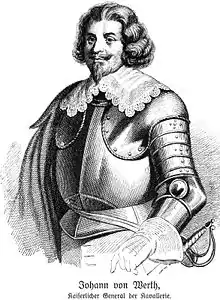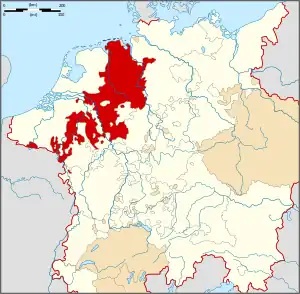Duchy of Jülich | |||||||||
|---|---|---|---|---|---|---|---|---|---|
| c. 1003–1794 | |||||||||
 Coat of arms
| |||||||||
.svg.png.webp) Map of the Lower Rhenish–Westphalian Circle around 1560, Duchy of Jülich highlighted in red | |||||||||
| Status | State of the Holy Roman Empire | ||||||||
| Capital | Jülich | ||||||||
| Common languages | Ripuarian | ||||||||
| Government | Duchy | ||||||||
| Historical era | Middle Ages, Renaissance | ||||||||
• Gerhard I, first count | c. 1003 | ||||||||
• Raised to duchy | 1356 | ||||||||
• United with Berg | 1423 | ||||||||
| 1521 | |||||||||
| 1614 | |||||||||
• Annexed by France | 1794 | ||||||||
| 1815 | |||||||||
| |||||||||
The Duchy of Jülich (German: Herzogtum Jülich; Dutch: Hertogdom Gulik; French: Duché de Juliers) comprised a state within the Holy Roman Empire from the 11th to the 18th centuries. The duchy lay west of the Rhine river and was bordered by the Electorate of Cologne to the east and the Duchy of Limburg to the west. It had territories on both sides of the river Rur, around its capital Jülich – the former Roman Iuliacum – in the lower Rhineland. The duchy amalgamated with the County of Berg beyond the Rhine in 1423, and from then on also became known as Jülich-Berg. Later it became part of the United Duchies of Jülich-Cleves-Berg.
Its territory lies in present-day Germany (part of North Rhine-Westphalia) and in the present-day Netherlands (part of the Limburg province), its population sharing the same Limburgish dialect.
History
County
In the 9th century a certain Matfried was count of Jülich (pagus Juliacensis).[1] The first mention of a count in the gau of Jülich in Lower Lorraine, is Gerhard I, in 1003; his grandson Gerhard III began to call himself Count of Jülich in 1081.
William IV, who became count in 1219, significantly enlarged the territory and in 1234 granted Jülich town privileges. By 1240 his territorial expansion created conflict on the eastern side of his territory with the Archbishop of Cologne Konrad von Hochstaden, whose troops devastated the city five years later.
William IV's son Walram (Count from 1278 to 1297) remained a fierce opponent of the Bishopric, supporting Duke John I of Brabant at the 1288 Battle of Worringen against Archbishop Siegfried II of Westerburg. Walramwas succeeded by his younger brother Count Gerhard V who had sided with German king Adolf of Nassau against his rival Albert I of Habsburg.Gerhard managed to retain his territories after Adolf of Nassau lost the Battle of Göllheim in 1298, and in 1314 supported the coronation of Louis IV of Wittelsbach at the nearby City of Aachen, once more against the will of the Cologne bishop.
Duchy
Gerhard died in 1328. His eldest son succeeded him as Count William V.[2] Gerhard's younger son Walram became Archbishop of Cologne in 1332. In 1336 Count William received the title of margrave from Emperor Louis IV, and in 1356 Emperor Charles IV of Luxembourg raised William V to the rank of duke. His son Duke William II, however, became entangled in a fierce feud with the Emperor's half-brother Wenceslaus of Luxembourg, Duke of Brabant, whom he defeated at the Battle of Baesweiler in 1371.[3]
Thereafter Jülich's history became closely intertwined with that of its neighbours: the Duchies of Cleves and Berg as well as Guelders and the County of Mark: Duke William II had married Mary, the daughter of Duke Reginald II of Guelders, and duchess herself after the death of her half-brother Reginald III of Guelders in 1371. William II settled the conflict with the Imperial House of Luxembourg and his son William III inherited both duchies, thereby becoming William I of Guelders and Jülich.
In 1402, Duke William I Guelders and Jülich died without any legitimate offspring. He was succeeded by his younger brother Reinald IV, Duke of Guelders and Jülich, who also died without heirs in 1423. The Gelderland estates chose Arnold of Egmond as duke, while Jülich amalgamated with Berg and passed to Adolf, Duke of Jülich-Berg, who belonged to a younger branch, and who had obtained Berg by virtue of the marriage of one of his ancestors.[1]
In 1511 Duke John III of Cleves inherited Jülich and Berg through marriage with Maria of Jülich-Berg, the daughter of the last Duke, William IV. She inherited her father's estates: Jülich and Berg with the County of Ravensberg. From 1521 Jülich-Berg and Cleves formed the United Duchies of Jülich-Cleves-Berg[1] in a personal union under Duke John III.[4]
When the last duke of Jülich-Cleves-Berg died without direct heirs in 1609, the War of the Jülich Succession broke out. It ended with the 1614 Treaty of Xanten, which divided the separate duchies between Palatinate-Neuburg and the Margraviate of Brandenburg. Jülich and Berg fell to Count Palatine Wolfgang William of Neuburg and after the last duke of Palatinate-Neuburg (also Elector of the Palatinate from 1685) Charles III Philip had died without issue in 1742, Count Charles Theodore of Palatinate-Sulzbach (after 1777 also Duke of Bavaria) inherited Jülich and Berg.
In 1794 Revolutionary France occupied the Duchy of Jülich (Duché de Juliers), which became part of the French département of the Roer. The Treaty of Lunéville in 1801 officially acknowledged the cession of Jülich to France. In 1815, following the defeat of Napoleon, the duchy became part of the Prussian[1] Province of Jülich-Cleves-Berg (after 1822 part of the Prussian Rhine Province), except for the cities Sittard and Tegelen, which became part of the United Kingdom of the Netherlands.
Rulers

Counts of Jülich
- 1003–1029 Gerhard I, Count in the Jülichgau
- 1029–1081 Gerhard II
- 1081–1128 Gerhard III, Count of Jülich
- 1128–1142 Gerhard IV
- 1142–1176 William I
- 1176–1207 William II
- 1207–1219 William III
- 1219–1278 William IV
- 1278–1297 Walram
- 1297–1328 Gerhard V
- 1328–1356 William V, margrave from 1336, duke from 1356 as William I
Dukes
— 1393–1423 in Union with Guelders, from 1423 with Berg, from 1437 with Ravensberg —
- 1356–1361 William I (previously Count of Jülich)
- 1362–1393 William II
- 1393–1402 William III, also Duke of Guelders since 1377
- 1402–1423 Reinald
- 1423–1437 Adolf
- 1437–1475 Gerhard
- 1475–1511 William IV
House of La Marck, Dukes
– from 1521 a part of the United Duchies of Jülich-Cleves-Berg –
- 1511–1539 John
- 1539–1592 William V
- 1592–1609 John William I
House of Wittelsbach, Dukes
– in union with Berg and Palatinate-Neuburg, after 1690 also with the Electorate of the Palatinate, from 1777 also with Bavaria–
- 1614–1653 Wolfgang William
- 1653–1679 Philip William
- 1679–1716 John William II
- 1716–1742 Charles Philip
- 1742–1794 Charles Theodore
Cities
Several cities and municipalities belonged to the Duchy of Jülich: - Jülich • Düren • Münstereifel • Euskirchen • Nideggen • Bergheim • Kaster • Grevenbroich • Mönchengladbach • Dahlen • Dülken • Linnich • Randerath • Brüggen • Süchteln • Aldenhoven • Heimbach • Monschau • Wassenberg • Heinsberg • Gangelt • Geilenkirchen • Waldfeucht • Sittard • Susteren • Sinzig • Tegelen • Remagen.
Notable people from the Duchy of Jülich
- Rabbi Isaac ben Meir of Duren, rabbi, author of Shaarei Dura (13th century)
- Carl Joseph Begas, painter, father of German sculptor Reinhold Begas (1794–1854)
- Gottfried Ludolf Camphausen, banker and politician, Prime Minister of Prussia (1803–1890)
- Anne of Cleves, noblewoman, Queen of England, fourth wife of Henry VIII (1515–1557)
- Peter Gustav Lejeune Dirichlet, mathematician (1805–1859)
- Statius von Düren, terracotta sculptor (1520–1570)
- Hendrick Goltzius, printmaker, draftsman, and painter (1558–1617)
- Hermann Heinrich Gossen, economist (1810–1858)
- Herman op den Graeff, Mennonite community leader (1585–1642)
- Friedrich Joseph Haass, physician, "holy doctor of Moscow" (1780–1853)
- Arnold von Harff, traveller and writer (1471–1505)
- Karl Heinzen, revolutionary author (1809–1880)
- Henriette Jügel, painter (1778–1850)
- Maria of Jülich-Berg, noblewoman, Duchess of Jülich-Berg, mother of Sibylle, Anne and Amalia (1491–1543)
- Hermann Löher, author (1595–1678)
- Nikolaus von Maillot de la Treille, military man holding the rank of Lieutenant General, Minister of War of the Kingdom of Bavaria (1774–1834)
- Heinrich von der Mark, military man holding the rank of Lieutenant General, Minister of War of the Kingdom of Bavaria (1782–1865)
- Jacob Masen, Jesuit priest, historian, dramatist and theologian (1606–1681)
- Gerardus Mercator, geographer, cosmographer and cartographer, whose parents were originally from Gangelt in the Duchy of Jülich (1512–1594)
- Jean-François Oeben, cabinetmaker, one of the most famous ébénistes, author of the Bureau du Roi and maternal grandfather of Eugène Delacroix
- Goschwin Nickel, Jesuit priest, the tenth Superior-General of the Society of Jesus (1582–1664)
- Saint Irmgardis, saint (1000–1065 or 1082/1089)
- Johann Wilhelm Schirmer, painter (1807–1863)
- Carl Caspar von Siebold, anatomist, surgeon, obstetrician and professor, considered the founder of modern academic surgery (1736–1807)
- Friedrich Spee, Jesuit priest, professor, and poet (1591–1635)
- Peter Stumpp, farmer and alleged serial killer accused of werewolfery (c. 1535–1589)
- Chrétien Urhan, violinist, violist, organist and composer (1790–1845)
- Johann von Werth, general of cavalry in the Thirty Years' War (1591–1652)
- Johann Weyer, physician and occultist (1515–1588)
- William I of Guelders and Jülich, Duke of Guelders and Jülich, known for his military activities and bellicose attitude (1364–1402)
References
- 1 2 3 4 Chisholm, Hugh, ed. (1911). . Encyclopædia Britannica. Vol. 15 (11th ed.). Cambridge University Press. pp. 549–550.
- ↑ Walther Möller, Stammtafeln westdeutscher Adelsgeschlechter im Mittelalter (Darmstadt, 1922, reprint Verlag Degener & Co., 1995), Vol. 1, page 14.
- ↑ Vaughan, Richard (2009). Philip the Bold. The Boydell Press. p. 209.
- ↑ Haude, Sigrun (2000). In the Shadow of "Savage Wolves": Anabaptist Münster and the German Reformation During the 1530s. Brill. p. 72.
External links
- Edicts of Jülich, Cleves, Berg, Grand Duchy Berg, 1475–1815 (Coll. Scotti) online
- Settlement of Dortmund between Brandenburg and Palatinate-Neuburg and the conflict of succession in Jülich, full text
- Map of the Duchy of Jülich in 1789
- Genealogie-Mittelalter Family of the Counts of Jülich





